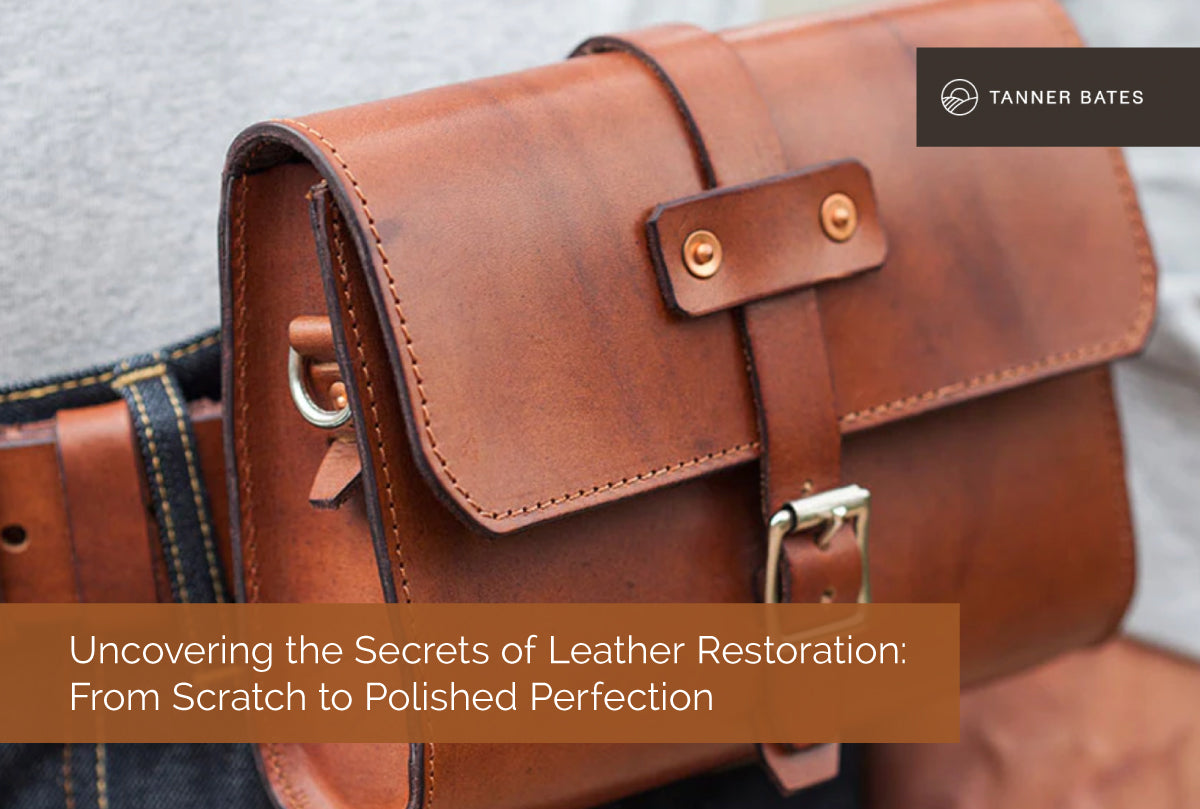
Uncovering the Secrets of Leather Restoration: From Scratch to Polished Perfection
Uncovering the Secrets of Leather Restoration: From Scratch to Polished Perfection
Whilst leather restoration isn't a service that we offer at Tanner Bates, being passionate about all things leather, we understand that everyone has their favourite leather item – whether it's a well-worn jacket, a vintage sofa, or a cherished handbag passed down through generations. These leather pieces hold a special place in our hearts, often linked to fond memories and stories.
However, over time, even the most durable leather can show signs of wear and tear, such as scratches, cracks, and fading. It is important to look after your leather, so here are some general and hopefully helpful thoughts on this topic.
It is always recommended to reach out to the manufacturer/maker of the specific leather piece in question wherever possible and follow their specific leather care instructions.
It is always recommended to reach out to the manufacturer/maker of the specific leather piece in question wherever possible and follow their specific leather care instructions.
In this comprehensive guide, we'll walk you through the process of restoring your beloved leather items to their former glory. We'll explore the different types of leather damage, the step-by-step restoration process, and the importance of proper maintenance.
So, let's dive in and uncover the secrets of leather restoration, from scratch to polished perfection!
Understanding Leather Damage
Before we dive into the leather restoration process, it's essential to understand the different types of leather damage you might encounter. Leather is incredibly durable, but it's not indestructible. Here are some common forms of leather damage:
· Scratches and Scuffs: These surface-level imperfections are usually caused by sharp objects, rough surfaces, or even unruly pets. While unsightly, they're often easy to address.
· Cracks: When leather dries out and loses its natural oils and moisture, it can develop cracks which can worsen over time.
·
Fading: Prolonged exposure to sunlight and regular use can cause the leather's colour to fade or become dull.
Fading: Prolonged exposure to sunlight and regular use can cause the leather's colour to fade or become dull.
· Drying: Just like our skin, leather needs to stay hydrated. Without proper conditioning, it can dry out, leading to cracks and stiffness.
While everyday wear and tear, neglect, or improper care can contribute to these issues, there's no need to worry. Whether you need to tend to scratches, faded colour, or address other types of leather damage, there's a solution!

The Leather Restoration Process
Leather restoration is more than just a quick fix. It's a careful process that requires attention to detail, patience, and the right products. Before we dive into the steps, let's address an important consideration: safety first!
Leather restoration often involves the use of solvents and dyes. To avoid inhaling fumes, always wear gloves and work in a well-ventilated area.
We always recommend wherever possible following the specific leather care advice of the maker or manufacturer of the piece in question as depending on the tannage of the leather in question, different methods of leather care and/or restoration may be more appropriate. It is always prudent to test any leather care products on an inconspicuous part of the item initially and confirm you are happy with the results before commencing with the rest of the piece.
If you are in any doubt, it is always best to seek professional advice and assistance.
Now, let's explore the leather restoration process:
*The following steps are not appropriate for suede, nubuck or split leather. If in any doubt, seek professional advice for your specific project.
Step 1: Cleaning
It is always recommended to reach out to the manufacturer/maker of the specific leather piece in question wherever possible and follow their specific leather care instructions.
Every restoration journey begins with a thorough cleaning. Using a gentle natural leather cleaner, carefully remove any dirt, grime, or residue from the surface. This crucial step ensures that nothing interferes with the restoration process.
Step 2: Conditioning
Next, apply a high-quality natural leather conditioner. Conditioning/feeding helps replenish the leather's essential oils, helps restore its suppleness, and can help to prevent future damage. Tanner Bates' Hide Food, for example, is a pH-balanced blend of natural fats and oils that can help restore your leather's vitality. Or even better, if applied regularly throughout the life of your leather piece, can help to avoid the leather becoming dehydrated and cracking in the first place.
Apply a liberal dose to the grain side, leave it overnight, and brush off anything left that is not absorbed. For best results, repeat this process every three months or more often if the leather gets wet.
Step 3: Repairing Scratches and Scuffs
Light scratches and scuffs can often be fairly well disguised with some careful attention and polish. For deeper scratches, it may be necessary to try and dye the inside of the scratch in an attempt to help disguise the scratch.
Step 4: Addressing Cracks and Tears
If the leather begins to crack, this is usually a sign that the leather has become dehydrated, usually through a lack of proper care and regular feeding to replace the natural fats and oils, or through the leather becoming wet.
The best solution for minor cracks is to apply some feed in an attempt to rehydrate the leather, however deeper cracks is a sign that the leather may ultimately require replacing as once the fibres have lost their structural integrity this cannot be reinstated through the application of a feed/conditioner.
Step 5: Colour Restoration
Over time, leather can fade and lose its vibrant colour. Leather dyes and colourants can be used to help revive the leather's original colour. Remember, it's crucial to choose a colour that matches your leather to achieve a natural look. It is always prudent to try an inconspicuous piece first to ensure you are happy with the results before continuing with the entire piece. It can be difficult to achieve an even and consistent finish.
Step 6: Polishing
The final step in the restoration process is polishing. Using a suitable product, like Tanner Bates' Liquid Wax, buff the leather to enhance its shine and protect the restored surface.
DIY Repairs vs. Professional Restoration
While minor scratches and scuffs can often be addressed with a bit of a polish up and the right DIY leather repair products, extensive damage or valuable leather items may require professional attention. This is not a service that Tanner Bates is able to offer, however there are many reputable companies offering such expertise.
Maintaining Your Restored Leather
Once your leather items have been expertly restored, it's crucial to maintain their newfound beauty. Regular cleaning, conditioning, and proper storage can significantly prolong the life of your leather goods, ensuring they remain a treasured part of your collection for years to come.
Additionally, it's important to avoid exposing your leather to harsh sunlight, damp/wet conditions or extreme temperatures, as these can accelerate the ageing process and undo all your hard work.

About Tanner Bates
Tanner Bates is a Devon-based company that specialises in handcrafted leather goods and premium leather care products. With a passion for unique, bespoke creations, Tanner Bates is committed to offering high-quality items that stand the test of time. Among their best-selling offerings is the Leather Care Kit, a comprehensive collection that includes everything you need to keep your leather items in pristine condition.
This kit features Tanner Bates' renowned Hide Food, a nourishing leather conditioner, their Liquid Wax for a beautiful shine, an applicator cloth, a horsehair polishing brush, and a comprehensive leather care guide to help you maintain your leather's radiance.

Your cherished leather items are more than just material possessions; they're a reflection of your personal style and a testament to timeless elegance. By investing in proper leather care and restoration, you can extend the lifespan of these treasured pieces, ensuring they remain a part of your life for years to come.
At Tanner Bates, we're dedicated to providing you with the highest quality leather care products.
Remember, leather restoration is not just about fixing scratches or cracks; it's about preserving the stories and memories woven into each piece. So, why not start today?
Explore our leather care products and embark on your own leather restoration adventure. Your beloved leather items deserve the best, and the Tanner Bates Leather Care Kit is here to help you achieve that.
FAQs About Leather Restoration
1. What are the first steps in leather restoration?
It is always recommended to reach out to the manufacturer/maker of the specific leather piece in question wherever possible and follow their specific leather care instructions. The leather restoration process begins with thoroughly cleaning to remove any surface dirt and grime. This is followed by conditioning with a quality product like Tanner Bates' Hide Food to replenish natural oils and help protect against future damage.
2. Can scratches and scuffs on leather be repaired at home?
Yes, usually light scratches and scuffs can often be buffed out or disguised using DIY methods. This is all part of the leather developing its natural patina over time.
3. How do you restore the colour of faded leather?
Restoring the colour of faded leather involves using leather dyes and colourants that match the original colour of the item. This step revives the vibrant appearance of the leather.
4. What should I do if my leather item has severe cracks or tears?
For minor cracks, conditioning might suffice. However, significant damage or tears usually require professional leather repair services to ensure a high-quality finish, if repair is even an option. Sadly, once the leather has lost the structural integrity of the fibres and begun to perish, ultimately little can be done to save it. Prevention is always better than the cure, so remember to love your leather throughout its life with a Tanner Bates Leather Care Kit!
5. How can I maintain my leather items after restoration?
Maintaining restored leather involves regular cleaning, conditioning, and proper storage. To prevent accelerated ageing, avoid exposing leather to extreme temperatures, moisture or direct sunlight.
6. Why choose Tanner Bates products for leather restoration and care?
Tanner Bates, based in Devon, specialises in handcrafted leather goods and premium leather care products. Their expertise and high-quality offerings, like the Leather Care Kit, ensure that your leather items receive the best care possible.
Leave a comment
Comments will be approved before showing up.
Also in News

Boutique Hotels in Devon: The Insider’s Guide to the Most Charming Stays
You’re seeking that perfect escape, somewhere that captures your heart the moment you arrive. Devon’s picturesque countryside and stunning coastline deliver exactly that magic. Golden sandy beaches, dramatic moorland that takes your breath away in places like Exmoor National Park. Those picture-perfect seaside towns you see on postcards, they’re real, and they’re here.

Top magical wedding venues in Devon (2025 Guide)
Planning the perfect wedding venue? Look no further than DEVON.
This stunning county doesn't just offer wedding venues - it delivers extraordinary locations where your love story unfolds against backdrops that take your breath away. From dramatic coastal cliffs to ancient country estates, Devon serves up variety like nowhere else.

Why Handmade Leather Menu Covers Are Worth Every Penny for Your Restaurant
Your guests settle into their seats, anticipation building before they've even glimpsed your carefully crafted menu. What's the first thing they touch?
Your leather menu covers.
That moment - that first tactile encounter - sets the stage for everything that follows. Dining engages all five senses, and smart restaurateurs know this. The weight of quality leather, its distinctive texture, the subtle aroma that whispers of craftsmanship - these details matter more than most realise.

